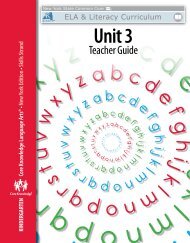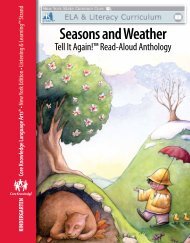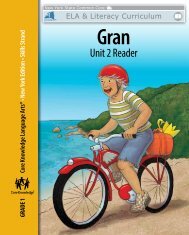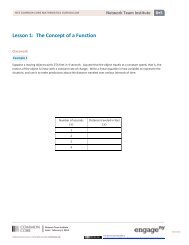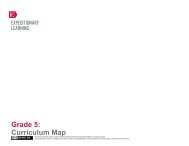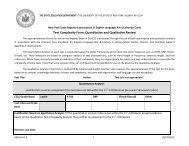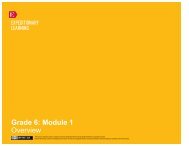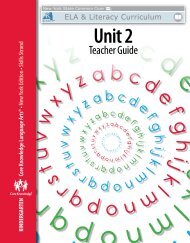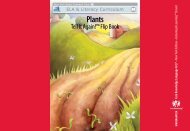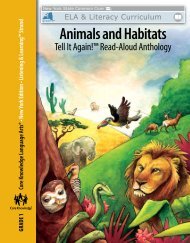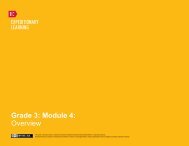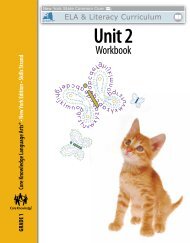Skills Unit 2 Teacher Guide - EngageNY
Skills Unit 2 Teacher Guide - EngageNY
Skills Unit 2 Teacher Guide - EngageNY
Create successful ePaper yourself
Turn your PDF publications into a flip-book with our unique Google optimized e-Paper software.
• If the draft contains dialogue, discuss how it has to be marked with<br />
quotation marks and make corrections if necessary.<br />
• If you have time before you have to move on to copying the draft, you can go<br />
beyond the questions listed on the editing checklist. For example, you may<br />
ask students if there are places where the author of the day could add details<br />
about his/her opinions about the story.<br />
• You can also ask students if they have any other suggestions to improve the<br />
author’s writing. Explain to students they should make suggestions by asking<br />
the author questions.<br />
• Model this by using an example like this: “I am wondering if we might make<br />
the author’s writing even better if we ...?” Using this phrasing will make it<br />
clear the author is being given suggestions for consideration rather than<br />
mandatory changes.<br />
• If changes are suggested, check with the author to see if he or she likes the<br />
idea. Then make the changes on the chart paper. At this stage, two or three<br />
suggestions are probably enough.<br />
• Save this edited draft for use by the author for Lesson 14.<br />
Reading Time<br />
30 minutes<br />
Partner Reading: “The Pancake, Part II”<br />
Introducing the Story<br />
• Review “The Pancake, Part I” with students. Discuss the characters, setting,<br />
and plot.<br />
Chapter 8<br />
• Tell students they will read “The Pancake, Part II” today.<br />
Previewing Spellings<br />
• In “The Pancake, Part II,” students will see the recently reviewed spellings of<br />
‘ar’, ‘er’, and ‘or’. Preview the words that have these spellings on the chart<br />
you prepared in advance with students.<br />
Worksheets 13.2, 13.3, 13.4<br />
• Additionally, students may need some guidance in chunking the words into<br />
syllables. You may want to use your hand to cover the second syllable of a<br />
word as students read the first syllable. Then use your hand to cover the first<br />
syllable a students read the second syllable. After both syllables have been<br />
read, ask students to blend and read. (Please refer to Appendix B to learn<br />
more about chunking syllables to decode words.)<br />
Note: For the word are, students may be tempted to read it as a separated<br />
digraph. Circle ar in are and explain that these sounds blend together (you<br />
may mark are on your Tricky Word wall as a now decodable word). For<br />
the word nearer, pronouncing the ‘r’ followed by ‘er’ may be a challenge.<br />
Please point out to students that farmers actually contains both the ‘ar’ and<br />
the ‘er’ spellings recently reviewed.<br />
120 <strong>Unit</strong> 2 | Lesson 13<br />
© 2013 Core Knowledge Foundation



